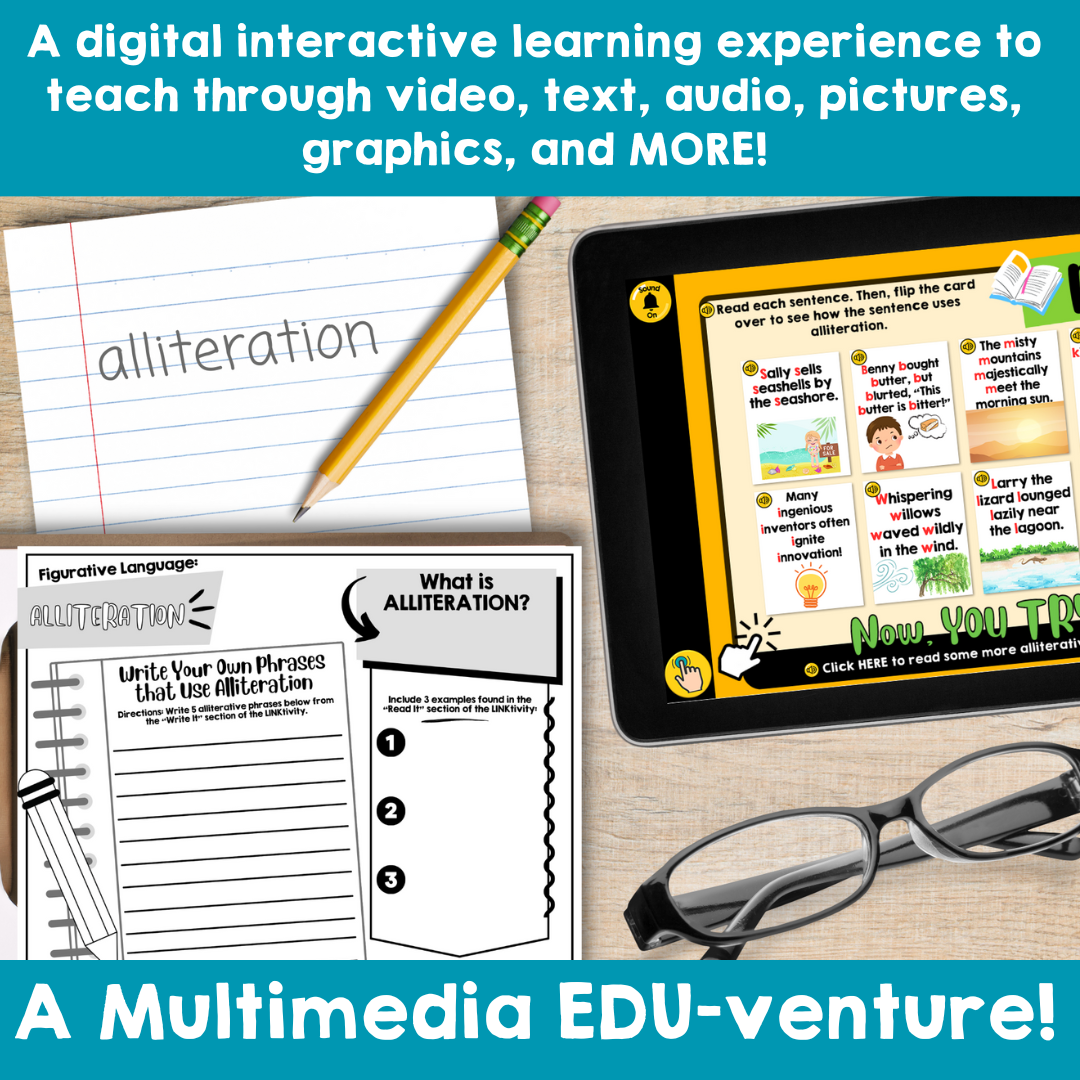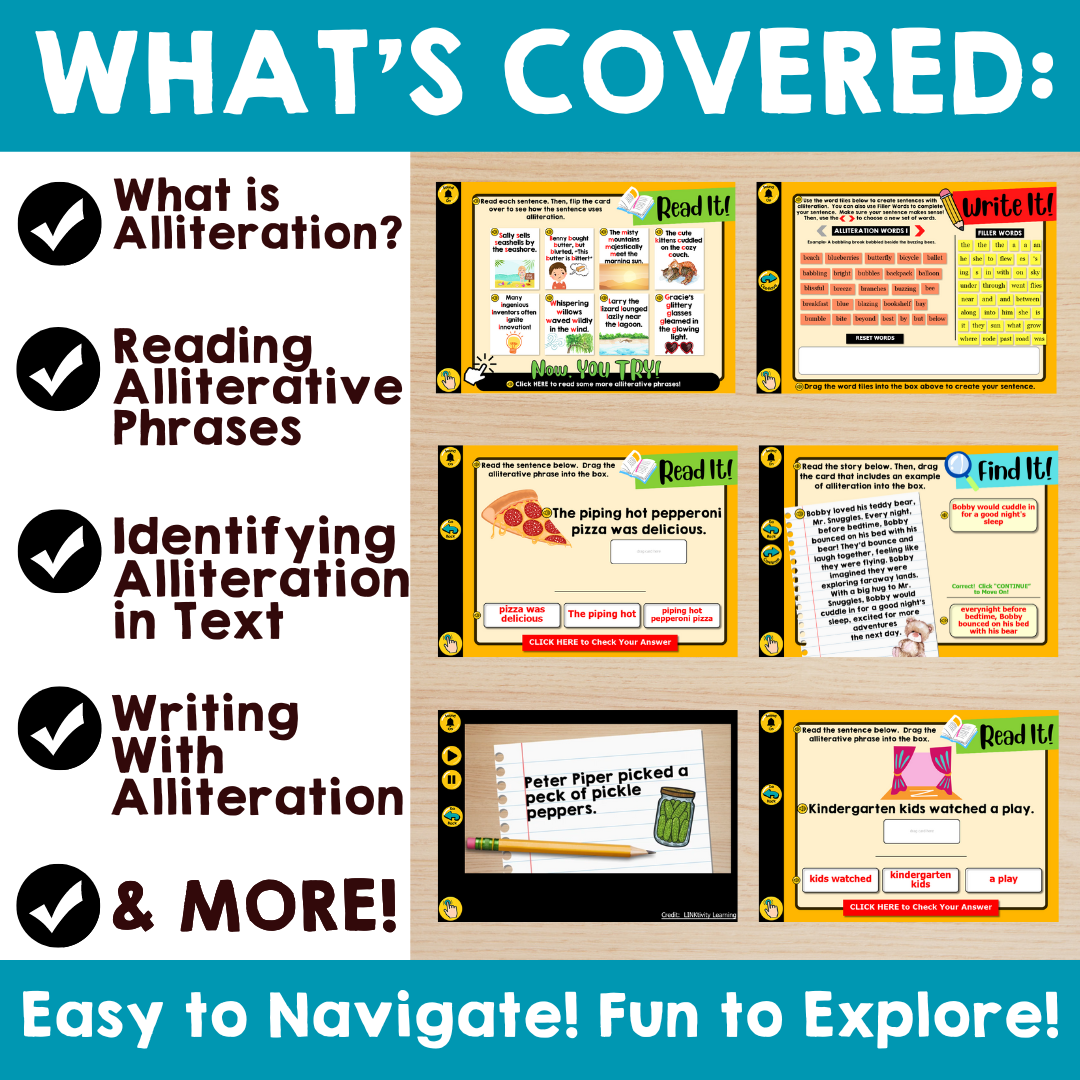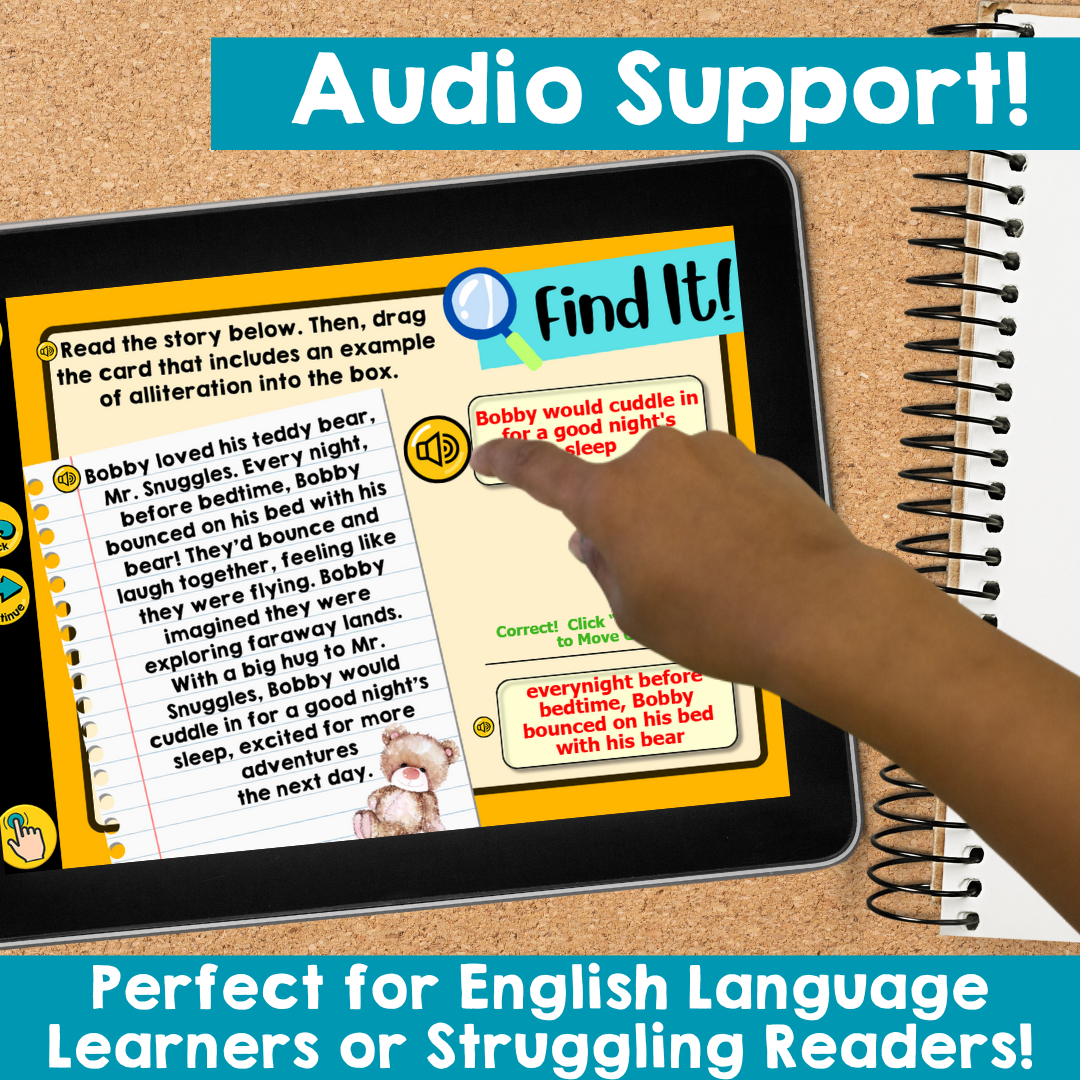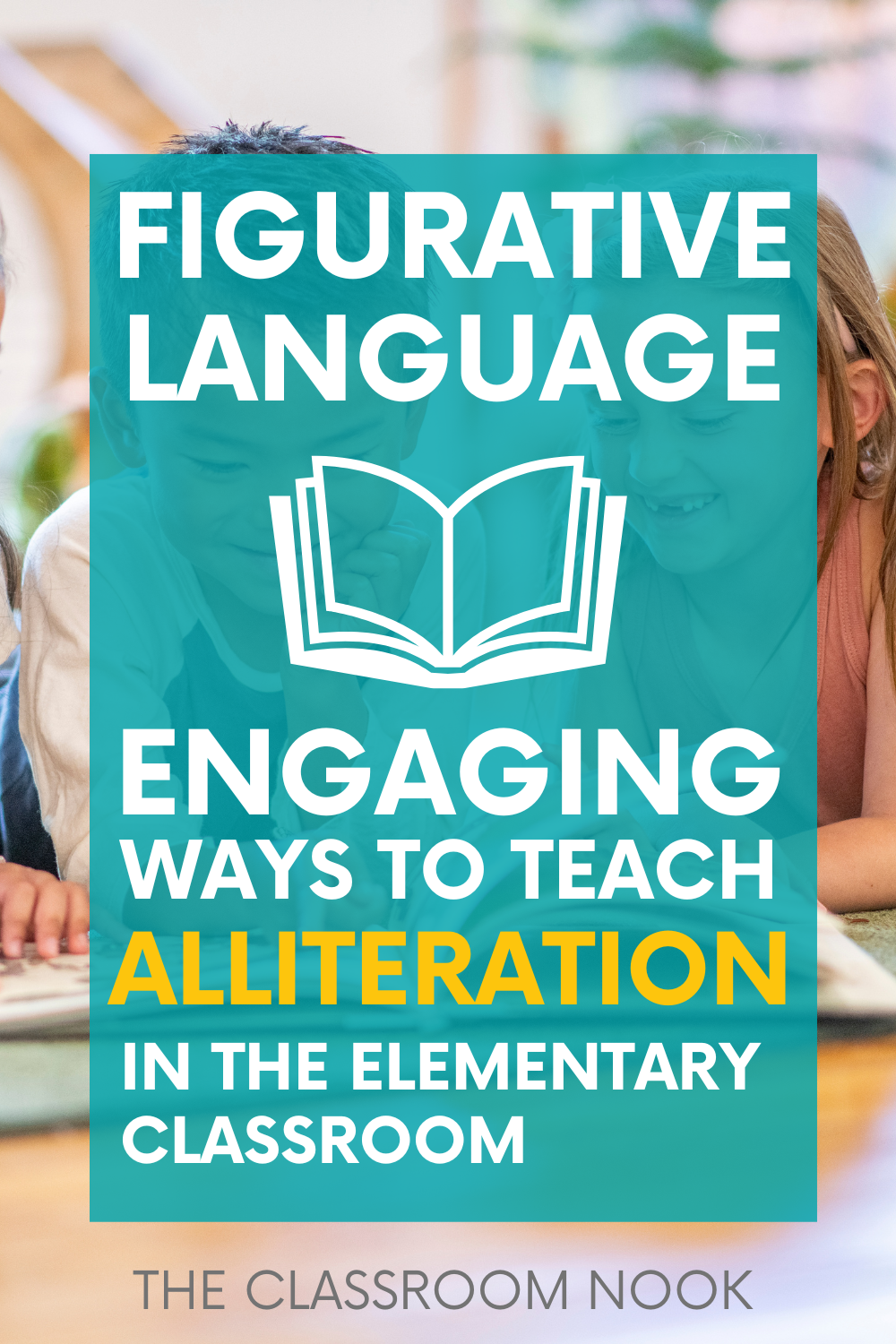From A to Z: Alliteration Made Easy (Step-by-Step Teaching Strategies)
If you're like me, you know that teaching figurative language to upper elementary students can be both rewarding and challenging. One figure of speech that often sparks creativity and enthusiasm in the classroom is alliteration.
But - alliteration isn't just about tongue-twisting sentences or catchy phrases; it's a powerful tool for developing language skills and nurturing creativity in young minds. By understanding and using alliteration effectively, we can help our students become better readers, writers, and communicators.
Sometimes, as teachers, we might find ourselves scratching our heads, wondering how to make teaching this literary device both engaging and understandable for our students.
In this post, we're going to delve into the wonderful world of alliteration and break it down from A to Z, making it simple and enjoyable for both you and your students.
This post on alliteration is part of our blog series on teaching figurative language. Be sure to follow along in the series for step by step strategies for incorporating figurative language into your literacy instruction!
Other Posts in this Series
Hyperbole Lessons & Activities That Will Make Your Class Roar with Laughter
Personification (Coming Soon!)
Onomatopoeias (Coming Soon!)
Idioms (Coming Soon!)
Understanding Alliteration
Before we jump into teaching strategies, let's make sure we're all on the same page about what exactly alliteration is. In its simplest form, alliteration is the repetition of initial consonant sounds in neighboring words within a phrase or sentence. For example, "Sally sells seashells by the seashore" is a classic example of alliteration, where the "s" sound is repeated.
It’s important to note that alliteration does not mean always repeating the same letter, but rather the sound. As teachers, we want to be careful in our language that we emphasize that it is the repetitive sounds that make a phrase alliterative, not necessarily the letter.
FREE POSTERS
Snag this FREE set of 7 posters to display in your classroom as you teach about types of figurative language.
Why Teach Alliteration?
Now, you might be wondering, "Why is alliteration important?" Well, besides being a great tongue twister, alliteration plays a crucial role in developing language skills and enhancing creativity. It helps improve reading fluency and comprehension by drawing attention to the sound patterns in words. Plus, it adds rhythm and musicality to writing, making it more engaging and memorable for readers.
Whether it's through tongue twisters, poetry, or storytelling, alliteration has a way of captivating young minds and fostering a love of language.
So, why should we bother teaching figurative language, specifically alliteration to our students in grades 3-5? Well, for starters, alliteration is more than just a fancy literary device; it's a fundamental building block of language that helps develop important literacy skills.
One of the key benefits of teaching alliteration is its connection to phonemic awareness – the ability to recognize and manipulate individual sounds in words. By focusing on the repetition of initial consonant sounds, we can help students sharpen their listening skills and become more adept at decoding words.
But that's not all! Alliteration also plays a crucial role in expanding vocabulary and improving writing skills.
By encouraging students to experiment with sound patterns and wordplay, we can help them become more creative and expressive writers. Plus, alliteration adds an extra layer of fun and flair to their writing, making it more engaging for both the writer and the reader.
Activities for Teaching Alliteration
Alright, it's time to roll up our sleeves and get down to business. Teaching alliteration doesn't have to be rocket science – with the right strategies and a little creativity, you can make it a breeze for your students - not to mention, FUN!
Activity 1: Start With a Video.
Harness the power of visual learning by incorporating engaging videos into your lessons. I made a video to go along with our LINKtivity series on Figurative Language that is specific, short, and kid-friendly to serve as a great jumping off point. Feel free to use it with your students, too!
Be sure to check out the Alliteration LINKtivity (as well as the complete LINKtivity series on Figurative Language)
Inside the resource you’ll find:
An interactive, multimedia LINKtivity® all about alliteration with the video from above, guided practice, reading passages, drag and drop features, and MORE!
Teacher lesson plan
Classroom Poster
Student Recording Sheet
Activity 2: Make It Personal!
I love using student names to get the ball rolling when it comes to teaching alliteration. Invite students to write their names on their dry erase board or index card. Next, ask them to think of a descriptive word that starts with the same sound as their first name. For example, a student named Sarah might write: "Super Sarah" on her board/index card or a boy named Finn might write: "Fantastic Finn."
You can start with your own name as an example, writing it on chart paper. When each student has come up with their descriptive word, have several students share and chart their responses. Then, encourage students to expand their phrase into a sentence using more of the same letter sound." (e.g., "Super Sarah scored a goal at soccer on Saturday!") This activity not only cultivates creativity but also fosters a sense of ownership and engagement.
Activity 3: Incorporating Alliteration into Daily Routines:
Infuse alliteration into your daily classroom routines with lively greetings like "Marvelous Mathematicians Monday" or "Happy Tuesday, My Terrific, Talented Typers!" These playful greetings set a positive tone for the day while reinforcing the concept of alliteration in a memorable way.
Activity 4: Create an Alliteration Alphabet Book:
Challenge students to create an alliteration alphabet book, where each page features a different letter of the alphabet and an alliterative phrase or sentence to go along with it.
For example, "A is for awesome apple picking in the autumn" or "B is for bouncing bunnies in the backyard." This not only reinforces letter-sound relationships but also encourages creativity and imagination.
Of course, you’ll need to adjust your expectations based on your students’ age. Older students can be expected to write longer alliterative phrases with stronger, more creative vocabulary.
Activity 5: Explore Tongue Twisters with The Alliteration Game: Tongue-Twist-Trade!
One of the most fun ways to see alliteration in action is through tongue-twisters. Students love trying to repeat a tongue-twister as fast as they can without making any mistakes.
Write several tongue-twisters on strips of paper and ask students to choose partners and read their tongue twisters to each other. Turn this into a game called “Tongue-Twist-Trade!”
TO PLAY:
1) Provide each student with a slip of paper with an alliterative phrase on it.
2) Give students 10 seconds or so to find a partner. Each partner takes turns reading their alliterative phrase to each other, then trades papers and quickly finds another partner with their new phrase
3) Repeat trading for as long as time allows!
Get more milage out of these alliterative phrases by placing these strips of paper in a jar. Invite a student to choose a slip and read one each day to kick start a morning meeting, or as a way to send their classmates home for the day! This makes great fluency practice as well as a constant review of alliteration!
Using a tool like ChatGPT will give you endless tongue-twister options, or check out one of these tongue-twister books to have on hand in your classroom:
Buzz Blows Bubbles and Other Tongue Twisters by RH Disney and Alan Batson
Giggle Fit: Zany Tongue Twisters by Mike Artell
Rhyming Riddles and Tons of Tongue Twisters for Miles of Smiles by Edith Namm
Super School Side Splitters: A Tongue-Twister Tale by Quinlan B. Lee
Tongue Twisters to Teach Phonemic Awareness and Phonics: Beginning Consonants and Vowels by Joyce Kohfeldt
Finding Alliteration in Literature
Of course, a tongue-twister isn’t the only way to see alliteration in action! In fact, finding examples of alliteration in real literature is an authentic way for students to see how alliteration enhances the writing.
These mentor texts cater to alliteration, while still sharing easy-to-follow storylines that students will enjoy.
Chips, Cheese & Nana’s Knees by: Brian P. Cleary
Betty's Burgled Bakery by Travis Nichols
Spaghetti Slurping Sewer Serpent by Laura Ripes
Clara Caterpillar by Pamela Duncan Edwards
Some Smug Slug by Pamela Duncan Edwards
The Worrywarts by Pamela Duncan Edwards
Alligators All Around by Maurice Sendak
And, of course, poetry is a great place to find examples of alliteration. Teach Starter shares 11 great poems that use alliteration.
FREE POSTERS
Snag this FREE set of 7 posters to display in your classroom as you teach about types of figurative language.
There you have it – alliteration made easy! Make learning alliteration fun by keeping it fresh and offering up a variety of ways for students to experience alliteration in reading, writing, and speaking.
By infusing your lessons with the creativity and variety discussed in this post, you'll transform alliteration into an engaging and enjoyable learning adventure for your students.
And for a comprehensive resource to kick-start your journey into alliteration, explore our Alliteration LINKtivity, or check out our complete Figurative Language LINKtivity series.












